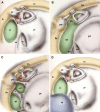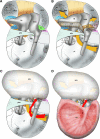Endoscopic anatomy of the middle ear
- PMID: 22468244
- PMCID: PMC3102170
- DOI: 10.1007/s12070-011-0159-0
Endoscopic anatomy of the middle ear
Abstract
Good knowledge of anatomy is fundamental for every surgeon. Middle ear anatomy is really complex and sometimes is challenging for otologists, who need to explore every single compartment for a radical removal of pathology. With introduction of the endoscope in middle ear surgery, anatomy of middle ear spaces has become wider and clearer due to a better magnification and to the possibility to look "behind the corner". This article is a review of the state-of-art of endoscopic middle ear anatomy with description of every compartment, with particular attention to ventilation pathways and middle ear folds.
Keywords: Anatomy; Endoscope; Middle-ear.
Figures













References
-
- Reuter HJ. Philipp Bozzini and endoscopy in the 19th Century. Stuttgart: Max Nitze Museum; 1988.
LinkOut - more resources
Full Text Sources
